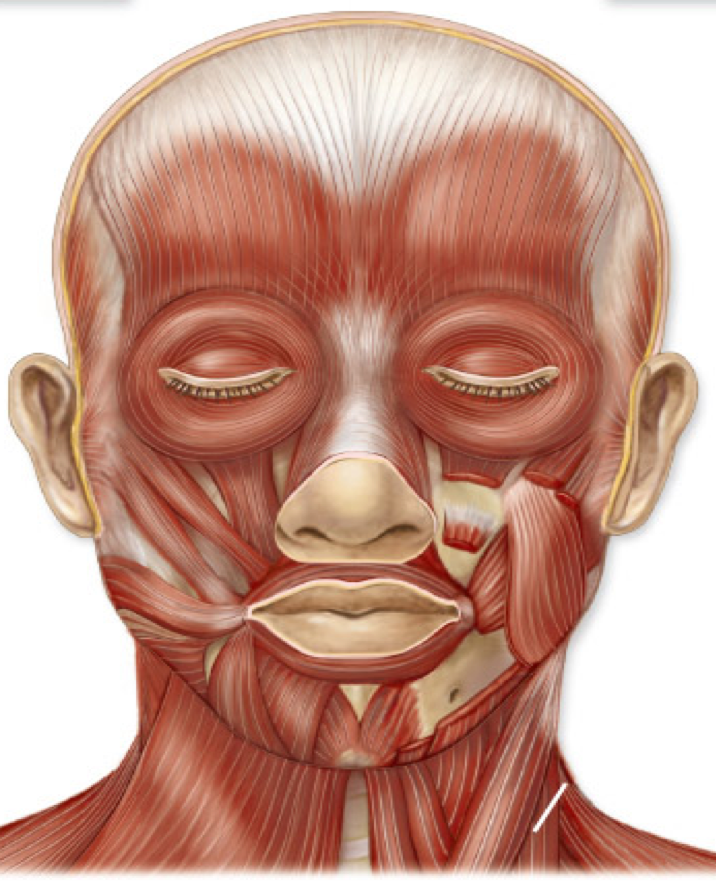By Michelle Gellis AP, DiplAc
The use of motor points in the acupuncture treatment of musculoskeletal pain has become very popular in recent years. Less familiar to most practitioners is the use of facial motor points in the treatment of both neuromuscular conditions, and for cosmetic purposes. The use of motor points to treat pain dates back to the work of A.H. Bennett, M.D. in 1882.1 More recently, the work of several researchers has built the foundation for the growing use of motor points by acupuncturists to restore muscle function.2
Motor points are located at the most electrically excitable part of the muscle where the motor nerve bundle is attached. More specifically, a motor point is defined as ‘the skin region where an innervated muscle is most accessible to percutaneous electrical excitation at the lowest intensity. This point, on the skin, generally lies over the neurovascular hilus of the muscle and the muscle’s band or zone of innervation.’3 When a muscle is in spasm, it has lost its ability to function properly. Correct needle insertion into the muscle’s motor point will cause it to ‘jump’, which resets the muscle to normal function. When a muscle is in flaccid state, it has also lost its ability to fire properly. By stimulating the motor point, the flaccid muscle can return to a functional state. Motor points are not the same as trigger points. Trigger points are tender points in the muscle that most people refer to as ‘knots’, which can refer pain to other parts of the body.4 Motor points tend to contain a larger concentration of nerve endings than other areas in the muscle and are more electrically excitable.5 They are neuromuscular junctions and are anatomically specific6
Facial motor points are unique in several ways: 1) Facial muscles are thinner than most of the muscles in our body therefore require a different needling technique. 2) Most muscles in our bodies attach to bones or other muscles, however facial muscles attach to our skin, giving us the ability to make facial expressions. Therefore, they can be used to rejuvenate the skin by relaxing tight muscle and wrinkles. 3) Unlike the motor points on the body, there are no huatuojiaji points that correspond to the motor points on the face.
Many facial motor points correspond with traditionally documented acupuncture points, such as Yangbai GB-14 for the frontalis muscle and Quanliao SI-18 for the zygomaticus major muscle.7 They are often located in the belly of the muscle. Motor points used in treating facial conditions are all innervated by the seventh cranial nerve, except those of the masseter and temporalis muscles. To determine which motor points to needle, one must identify which muscle(s) are affected. For example, if a patient cannot smile, there are four main muscles that may be affected. The zygomaticus major (which draws the angle of the mouth upward and outward), zygomaticus minor (elevates the upper lip), the levator labii superioris (elevates the upper corner of mouth) and the risorius (retracts the angle of the mouth laterally). Once the affected muscles have been identified, the corresponding motor points can be treated. Motor point needling is effective for many conditions involving paralysis. Needling a motor point helps a muscle to recover its length. Readers should note that learning to locate and needle facial motor points effectively typically requires special training, usually in a hands-on environment. Arnica gel is usually applied to the skin to prevent bruising, and a 0.16-millimeter gauge needle is inserted into the belly of the muscle and vigorously lifted and thrusted until the muscle jumps. If performed incorrectly, stimulation of a motor point can cause damage to the facial nerves. Proper screening for contraindications such as neuropathy or concurrent use of anticoagulants, or thrombocytopenia or lymphedema is essential. Recorded webinars on the use of facial motor points and live classes on cosmetic acupuncture can be accessed at https://www,facialacupunctureclasses.com.
Part of this article was taken from the Journal of Chinese Medicine • Number 110 • February 2016-A Multifaceted Approach to the Acupuncture Treatment of Neuromuscular Facial Conditions-Michelle Gellis
1 Bennet, A., (1882). A Practical Treatise on Electro-diagnosis in Diseases of the Nervous System. J.H. Vail & Company: New York
2 Gunn, C.C., Milbrandt, W.E, Little, A.S. & Mason, K.E. (2002). “Dry-Needling of Muscle Motor Points for Chronic Low-Back Pain: a randomized clinical trial with long-term follow-up” Spine, 5, 279-29
3 Callison, M., (2007). Motor Point Index: An Acupuncturist’s Guide to Locating and Treating Motor Points. AcuSport Seminar Series: San Diego
4 Hong, C.Z. (1994). “Lidocaine Injection Versus Dry Needling to Myofascial Trigger Point”, American Journal of Physical Medicine & Rehabilitation, 73, 256–263.
5Lomo, T. (1976) “The role of activity in the control of membrane and contractile properties of skeletal muscle” in Thesleff, S., (ed.). Motor Innervation of Muscle. Academic Press: London
6Walthard, K.M. & Tchicaloff, M. (1971). Motor points. Electrodiagnosis and electromyography. Licht, S., (ed.), Third Edition. Waverly Press: Baltimore, Chapter 6, p 153-170
7 Liu, Y.K., Varela, M. & Oswald, R., (1975). “The correspondence between some motor points and acupuncture loci”, American Journal of Chinese Medicine, 3, 347-358.


